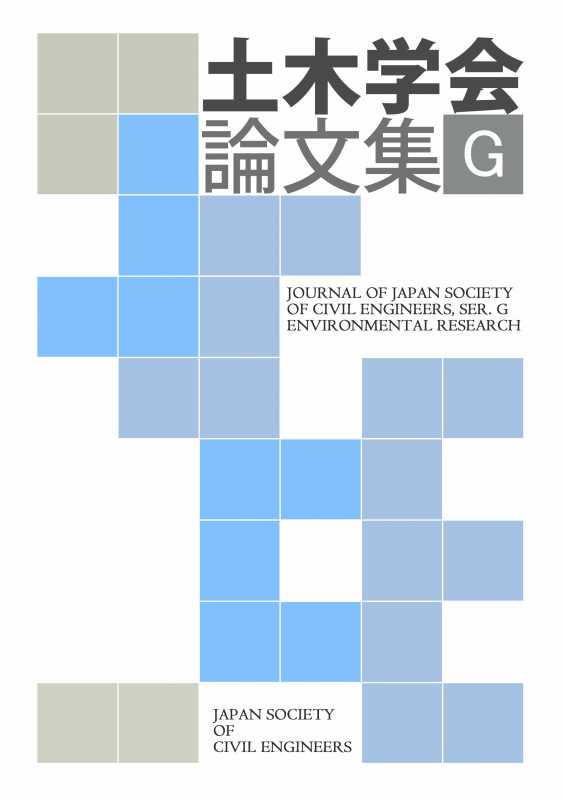All issues

Predecessor
- Doboku Gakkai Ronbunshuu G
- Proceedings of the Symposium on Global Environment
- PRE-PRINTS OF THE SYMPOSIUM ON GLOBAL ENVIRONMENT
- ENVIRONMENTAL SYSTEMS RESEARCH
- ENVIRONMENTAL SYSTEMS RESEARCH
- [journal title in Japanese]
- [journal title in Japanese]
- ENVIRONMENTAL ENGINEERING RESEARCH
- PROCEEDINGS OF ENVIRONMENTAL AND SANITARY ENGINEERING RESEARCH
- [journal title in Japanese]
Volume 73, Issue 3
Displaying 1-4 of 4 articles from this issue
- |<
- <
- 1
- >
- >|
Paper (In Japanese)
-
Naoyuki YAMASHITA, Yoshinori NISHIDA, Suntae LEE, Hiroaki TANAKA, Kent ...2017Volume 73Issue 3 Pages 101-111
Published: 2017
Released on J-STAGE: July 20, 2017
JOURNAL FREE ACCESSThis study evaluated removal efficiency of virus by coagulation and UF process aimed at water reuse and compared removal efficiencies between bacteriophage MS2 and Qß. From the results of batch experiment, removal of MS2 during coagulation was increased depending on increase of coagulant dose. Removal efficiency of Qß was higher than that of MS2 during coagulation. From the results of pilot plant experiment using coagulation and UF process, removal efficiency of MS2 during coagulation process was increased depending on the coagulant dose increase. The removal efficiency of MS2 was also increased during UF process by the addition of coagulant before UF process. Although removal efficiency of Qß was higher than that of MS2 during coagulation process in the pilot plant experiments, removal efficiency of MS2 was higher during UF process.View full abstractDownload PDF (410K) -
Reiko SODENO, Masaki TAKAOKA2017Volume 73Issue 3 Pages 112-120
Published: 2017
Released on J-STAGE: July 20, 2017
JOURNAL FREE ACCESSThe adoption in 2013 of the Minamata Convention on Mercury is expected to result in a decrease in global demand for mercury. Although most mercury in Japan is currently recovered from waste and byproducts and then exported, a future decrease in demand may result in an inevitable surplus in recovered mercury, which would have to be dealt with domestically. To consider future scenarios and capacity for final disposal, it is crucial to understand the future outlook for surplus mercury in Japan. This study, therefore, aims to provide basic information on the potential volume of this surplus.
The study illustrates future global trends for the supply-demand balance of mercury from 2010 to 2050 in Asia, North America, South America, Oceania, European Union, Russia, and Eastern Europe. Consideration is given to the impacts of the Convention, and quantities of surplus mercury in the world and Japan are projected based on three scenarios developed for this study. There is considerable uncertainty about the supply and demand of mercury in China, but the study predicts that a surplus will develop in Japan starting in 2020, when most demand for mercury in products will have been phased out, and the surplus will increase after 2025. The cumulative surplus in 2050 will likely amount to 24,000-25,000 tons worldwide, and 600 to 1,400 tons in Japan. Since the predicted surplus in Japan is likely to appear within just several years, current efforts to establish disposal schemes for mercury should be accelerated. International cooperation is also required in order to cope with the expected global surplus of mercury in an environmentally sound manner, by either long-term storage or final disposal, as technologies to treat mercury are limited to only a few developed countries.View full abstractDownload PDF (1266K) -
Keisuke KOJIMA, Kazuo OKAMURA, Masaharu TASAKI, Mark N. SUEYOSHI, Rash ...2017Volume 73Issue 3 Pages 121-133
Published: 2017
Released on J-STAGE: August 20, 2017
JOURNAL RESTRICTED ACCESSOily wastes such as oily tank sludge and oil contaminated soil, are among the largest waste problems in oil producing countries. In this study, oilfield wastes were characterized, and their carbonization with superheated steam was examined as a low cost method for treatment and recovery of oil.
Oil concentrations of oily waste measured by IR method were 59,800-217,000 mg/kg, depending on the type of waste. In addition, contaminant oils also differed according to waste type. Oil based mud was composed mainly of saturated hydrocarbons in the range of C12-C28. For other oily wastes, the concentrations of heavy oil in the range of C28-C44, were roughly 10-20% higher than those of Bunker C. Combined resin and asphaltene ratios were in the range of 33.7-40.0%. Therefore, a treatment method suitable for the complete range of hydrocarbons was required; rather than methods such as biological decomposition, suitable only for partial, lighter range of hydrocarbons.
After carbonization treatment, oil concentration in residues ranged from N. D. to 65 mg/kg. Oil removal efficiency for all oily waste types exceeded 99.9%. Additionally, upwards of 63.6% of oil in the wastes were recovered, with the recovery ratio varying from one waste type to another.
Finally, these results indicate the effectiveness of carbonization with superheated steam method for oily waste treatment and recovery of oil.View full abstractDownload PDF (1758K) -
Kazuaki MATSUI, Yuichi YOKOYAMA, Kunpei KAMEI, Yuzuru NAKAGUCHI, Mitsu ...2017Volume 73Issue 3 Pages 134-142
Published: 2017
Released on J-STAGE: September 20, 2017
JOURNAL FREE ACCESSWe explored the impact of combined sewer overflow (CSO) on the water quality of an urban river. We characterized the bacterial community of the Higashiyokobori-gawa waterway using next-generation DNA sequencing (Illumina Miseq). We examined bacterial 16S rRNA gene amplicons during rainfall periods. When rainfall exceeded 4 mm/h at our experimental site on the waterway, the bacterial community composition in the river water exhibited transient changes attributable to the CSO. The bacterial community composition in the waterway differed greatly from those in sewage, suggesting that the CSO had been diluted with bulk rainwater prior to discharge into the river. After a newly constructed stormwater storage pipe called Heisei-no-Taikougesui was commissioned, we found no changes in the bacterial community in river water even when rainfall exceeded 8 mm/h. This indicates that the storage pipe effectively prevented CSO discharge into the waterway. We suggest that bacterial community composition analysis is useful when evaluating/monitoring water quality.View full abstractDownload PDF (2760K)
- |<
- <
- 1
- >
- >|